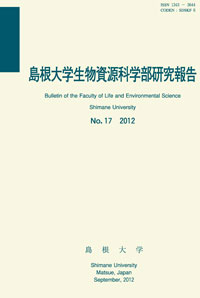島根大学生物資源科学部
ISSN:2435-0885(online)
ISSN:1343-3644(in print)
A publication of this bulletin in print format has not been made since no 24.
ISSN:1343-3644(in print)
A publication of this bulletin in print format has not been made since no 24.

number of downloads : ?
Use this link to cite this item : https://ir.lib.shimane-u.ac.jp/51413
Bulletin of the Faculty of Life and Environmental Science Shimane University 25
2020-09-30 発行
Antifungal activity of leaf extracts from several buckwheat varieties against plant pathogenic fungi
Description
Common buckwheat (Fagopyrum esculentum) and tartary buckwheat (F. tataricum) is a commonly grown food crop in Japan. The classic Japanese work on agriculture, Nihon Nousho Zenshu, mentions that extracts of buckwheat leaves were used to control rice blast in the Edo Period. Recently, we evaluated whether the characteristics associated with infection and fungal growth of rice blast fungus, Magnaporthe oryzae, the causal agent of rice blast disease, could be suppressed by using extracts of buckwheat leaves. However, it remains unclear whether leaf extracts of several buckwheat variety would show similar inhibitory activity against other plant-pathogenic fungi. In the present study, we evaluated the broader fungicidal activity of extracts of leaves of several buckwheat varieties against the pathogens Ceratocystis fimbriata, Cochliobolus miyabeanus, Corynespora cassiicola, Fusarium buharicum, and M. oryzae. We found that an ethyl acetate extract of common buckwheat leaves (cv. Harunoibuki, cv. Kitawasesoba, and cv. Shinano 1 gou), and tartary buckwheat leaves (F. tataricum: Dattansoba) significantly inhibited conidial germination of C. fimbriata, C. miyabeanus, C. cassiicola, F. buharicum, and M. oryzae. The ethyl acetate extract of common buckwheat leaves (cv. Harunoibuki, cv. Kitawasesoba, and cv. Shinano 1 gou), and tartary buckwheat leaves (Dattansoba) were shown to have fungicidal activity against C. fimbriata, C. miyabeanus, C. cassiicola, F. buharicum, and M. oryzae. These results suggest that fungicidal substances from the leaf extracts of common buckwheat and tartary buckwheat may be a promising source for the development of new chemical fungicides to prevent plant diseases caused by fungal pathogens.
About This Article
Other Article
